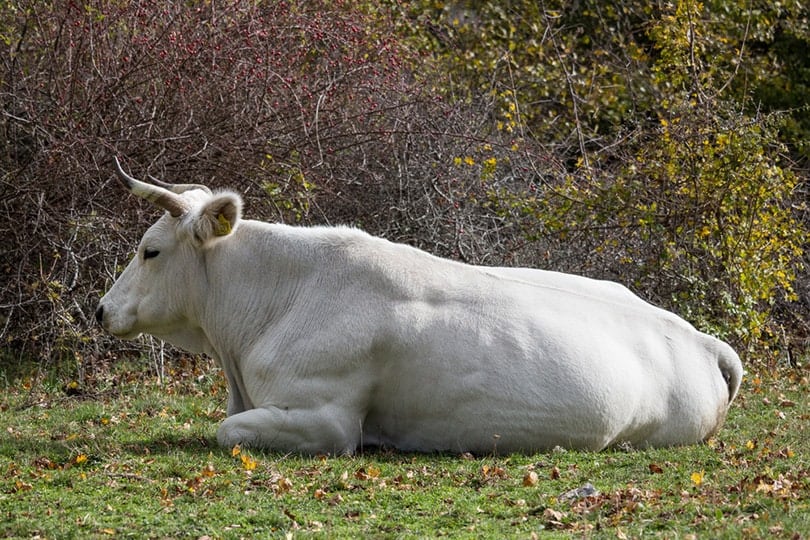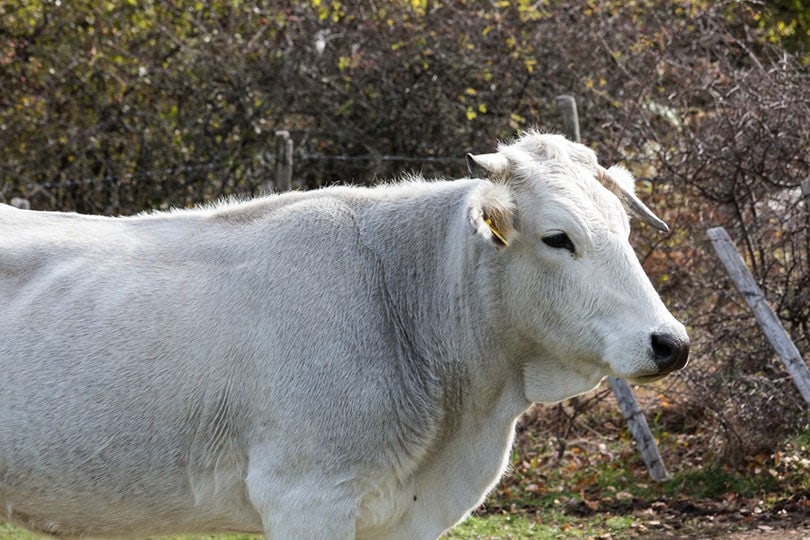The Marchigiana cattle breed, sometimes known as Del Cubante Avellino, is a large breed that originated in the province of Marche in Italy. The breed is still kept for beef today and is widespread throughout Italy and other areas of the world.
If you’ve ever been curious about Marchigiana cattle and what sets it apart from other similar breeds, keep reading. We’re going to go through everything there is to know about Marchigiana cattle and whether or not you should consider them for small-scale farming.

Quick Facts about Marchigiana Cattle Breed
| Breed Name: | Marchigiana Cattle Breed |
| Place of Origin: | Italy |
| Uses: | Beef |
| Bull (Male) Size: | 2,000–2,400 lbs |
| Cow (Female) Size: | 1,300–1,500 lbs |
| Color: | Light gray to white |
| Lifespan: | 15–20 years |
| Climate Tolerance: | All types |
| Care Level: | Low |
| Production: | Beef |
Marchigiana Cattle Breed Origins
The Marchigiana breed originated in the Marche and surrounding regions of Italy. There seem to be conflicting opinions regarding the exact origins of this breed. Some believe they were brought into Italy by the Barbarians after the fall of Rome. Others think that it was developed in the late 19th and 20th centuries through crossbreeding Podolian cattle with Chianina and Romagnola breeds.


Marchigiana Cattle Breed Characteristics
The breed was developed to do well in a wide variety of terrain and climates. They can survive dry and hot summers and cold, wet winters with poor quality roughage. Their pigmented skin ensures they have protection from solar radiation.
Marchigiana cattle will reach their ideal slaughter weight by the time they’re 16 months old. This results in yields as high as 67%.
They have great disease resistance and are fast maturing. This breed can sometimes exhibit double muscling, an inherited condition that’s caused by a mutation of the myostatin gene. Cattle with double muscling typically provide an increased yield of lean meat, but they also have a lot of problems like poor lactation, underdeveloped reproductive tracts, and susceptibility to heat stress.
Marchigiana cattle have early sexual maturity, calve with ease, and have great fertility. They often have a mild disposition and are chosen by producers thanks to their fast growth and feed efficiency.
Uses
Before the 1950s, Marchigiana cattle were bred for draft work as oxen. They would be trained to do work such as carry heavy loads around the farm.
Now, this breed is mostly used for their meat.
Younger cattle will produce tender and tastier beef. Older cattle can still produce tasty meat, but their carcass will need to be frozen first and hung for up to ten days to produce tender meat. Marchigiana meat is lean, well-marbled, and low in cholesterol.

Appearance & Varieties
Marchigiana cattle resemble the Chianina in many ways. They have similar coloring and conformation. Marchigiana cattle are very large and muscular but their bone structure is refined. They have short hair that varies in color from light grey to white.
Their medium-sized horns have black coloring at the tip, white throughout the middle, and a yellowish tint at the base. In males, the horns will have a slight curve forward. In females, the horns are curved slightly upward.
Marchigiana cattle have pigmented skin and black tongues and muzzles. The area around their eyes and tails also tends to be dark in color.
Bulls stand at around 61–62 inches and cows at 57 inches in height. Newborn calves are small, weighing in at roughly 80–100 pounds.
Distribution
Today, the Marchigiana breed makes up roughly 45% of the beef herd in all of Italy. There are around 50,000 head of Marchigiana cattle registered in Italy. They’re widespread throughout the country in areas like Abruzzo, Labium, and Campania, as well as in their area of origin, Marches.
Marchigiana cattle have also been exported internationally to the United States as well as Canada, Brazil, Great Britain, and New Zealand.

Are Marchigiana Cattle Good for Small-Scale Farming?
Beef cattle production can be a viable option for some small-scale farmers. Since Marchigiana cows are so large, however, they might not be a great option for most small-scale producers.
That said, they are easy to care for, healthy, hardy in all types of weather, and can take care of themselves. If you have the land available for grazing, keeping Marchigiana cattle wouldn’t be out of the realm of possibility.
Featured Image Credit: Andrea Luciani, Shutterstock
